- Quick Read
- Deep Read ( 4 Min. )
In Today’s Issue
- Biden’s food drops in Gaza point to difficulties with Israel
- Today’s news briefs
- Migrants, Mexican aid groups adapt to shifts at US border
- Filing taxes is hard. A new IRS program could change that.
- Moscow plans mini-Olympics. Will Russians be satisfied?
- In science and conservation, empowering the people
Monitor Daily Podcast
- Follow us:
- Apple Podcasts
- Spotify
- RSS Feed
- Download
TODAY’S INTRO
A different way to look at immigration
 Mark Sappenfield
Mark Sappenfield
Immigration can seem an impossible challenge. It is now the biggest issue in American and European politics.
But there’s perhaps a different way to look at it. Economic opportunity and political stability will always draw people. Humans want to make their lives better. So holding the issue at arm’s length is neither practical nor humane. The real question is, how can we best help?
Citizenship is one answer, but not the only one. Whitney Eulich’s story today explores other avenues. It shows that when we move beyond politically weaponizing the issue, we can accomplish remarkable things.
Share this article
Link copied.

Help fund Monitor journalism for $11/ month
Already a subscriber? Login

Monitor journalism changes lives because we open that too-small box that most people think they live in. We believe news can and should expand a sense of identity and possibility beyond narrow conventional expectations.
Our work isn't possible without your support.
Biden’s food drops in Gaza point to difficulties with Israel
With his airdrop of food in Gaza, U.S. President Joe Biden was trying to show compassion. Instead, he might have shown America’s inability to shape the situation more robustly.

With the U.S. airdrops of food into Gaza that began Saturday, the White House seemingly intended to portray President Joe Biden as a leader taking decisive action to alleviate human suffering. But international aid groups criticized the airdrops as woefully inadequate – more show than solution.
Moreover, the expensive and imprecise drops of thousands of ready-to-eat meals into a sealed enclave of more than 2 million hungry people – a second set was carried out Tuesday – quickly came to symbolize the American superpower’s unwillingness to restrain its close ally Israel’s right to self-defense.
It is Israel’s 5-month-old war on Hamas following the militant group’s Oct. 7 attack in Israel that has led to Gaza’s devastation. And it is Israel’s security clampdown on border crossings (along with similar actions by Egypt) that is at least partially responsible for the looming mass starvation.
With polls showing that a plurality of Americans now think Israel has gone too far in Gaza, the White House is expressing more forceful frustration with Israel.
“The Israeli government must do more to significantly increase the flow of aid,” Vice President Kamala Harris told an audience in Selma, Alabama, Sunday. “No excuses.”
Biden’s food drops in Gaza point to difficulties with Israel

If the U.S. airdrops of food into Gaza that began Saturday were meant to demonstrate the Biden administration’s strength and resolve to address a deepening humanitarian crisis, for many, the intervention had the opposite effect.
The White House seemingly intended to portray President Joe Biden as a leader taking decisive action to alleviate human suffering and mass hunger approaching starvation. But international aid groups with experience in addressing conflict-caused hunger roundly criticized the airdrops as woefully inadequate – more show than solution.
Moreover, the expensive and imprecise drops of thousands of ready-to-eat meals into a sealed enclave of more than 2 million hungry people – some pallets of the first 38,000 meals dropped Saturday fell into the sea – quickly came to symbolize the American superpower’s impotence and unwillingness to impose its will on close ally Israel.
It is Israel’s 5-month-old war on Hamas following the militant group’s Oct. 7 attack in Israel that has led to Gaza’s devastation – unprecedented rates of civilian deaths, vast infrastructure destruction, and looming mass starvation. And it is Israel’s security clampdown on border crossings (along with similar actions by Egypt, another recipient of significant U.S. aid) that is at least partially responsible for the crisis.
In particular, the airdrops – a second set was carried out Tuesday – only underscore for many Mr. Biden’s refusal since the beginning of the war to take any steps that might be construed as dictating actions to Israel or imposing any restraint on its right to self-defense.
“There is a mistaken belief that the United States is able to dictate to other countries’ sovereign decisions,” State Department spokesman Matthew Miller said at a press briefing Thursday.
To which a range of Americans, from national security experts to members of Congress and average citizens, are responding that of course the U.S. has leverage, as Israel’s largest benefactor and supplier of military aid.

On Sunday Sen. Bernie Sanders of Vermont called on President Biden to invoke the Foreign Assistance Act to demand that the government of Israeli Prime Minister Benjamin Netanyahu restore humanitarian aid access to Gaza or lose U.S. military assistance.
Quoting the section of the act that bars furnishing assistance to any country that “prohibits or otherwise restricts, directly or indirectly, the transport or delivery of United States humanitarian assistance,” Senator Sanders said Israel was in “clear violation” for “prohibiting aid convoys from delivering desperately needed food and water.”
At the State Department press briefing, Mr. Miller added that the U.S. will continue to support Israel and its “legitimate right” to protect itself and pursue policies aimed at preventing anything like the Oct. 7 attacks from occurring ever again.
But he also hinted at growing daylight between the U.S. and Israel.
“Israel makes its sovereign decisions,” he said. “We make clear where we disagree with them.”
Those disagreements have largely been aired behind closed doors, although Mr. Biden did tell reporters at the White House last month that Israel’s response to the Oct. 7 attacks was “over the top.”
But with polls showing that a plurality of Americans now think Israel has gone too far in its Gaza campaign, the White House appears to be getting the message and venturing into more forceful expressions of frustration with Israel.
On Sunday Vice President Kamala Harris deployed the administration’s harshest rhetoric yet, telling an audience in Selma, Alabama, that the war has caused a “humanitarian catastrophe” in Gaza. “The Israeli government must do more to significantly increase the flow of aid,” Ms. Harris said. “No excuses.”

She also called for a cease-fire – noting a deal is “on the table” that has Israel’s backing and which would halt fighting for perhaps six weeks – echoing a demand popular with many young Democrats and Gaza supporters, but one the president has until now shied away from articulating.
The newfound willingness to display widening differences with the Netanyahu government’s conduct of the war continued Monday, when Ms. Harris received Israeli wartime Cabinet member Benny Gantz at the White House. Mr. Gantz, a centrist, is a Netanyahu rival, with polls showing he would easily trounce the conservative prime minister if elections were held now.
The vice president underscored the need for a credible plan to reduce the risk to civilians before Israel launches any major military operation in the southern Gaza city of Rafah, the White House said in a statement. But there was no word of a presidential drop-in at the Harris-Gantz meeting, as some observers had speculated Mr. Biden might engineer as a way to highlight his growing frustration with Mr. Netanyahu’s conduct of the war.
As a growing number of foreign policy experts note, Mr. Biden has been great at deploying American power to support close allies in their moments of dire need, but not so good at pressuring them to change course when they falter.
As international affairs commentator Robert Wright observed in a recent column, the U.S. has “massive pressure” over Israel, but Mr. Biden has refused to use that leverage to influence a war Mr. Wright believes will ultimately not be good for Israel. (For the record, Mr. Wright says Mr. Biden is making the same mistake with Ukraine by not pressuring for an end to the war there.)
“Biden is good at showing love,” he says, “and catastrophically bad at showing tough love.”

Today’s news briefs
• Hamas sexual violence report: A United Nations report says that there are “reasonable grounds” to believe Hamas committed rape, “sexualized torture,” and other inhumane treatment of women during its surprise attack in southern Israel on Oct. 7.
• Ukraine drone sinks Russian ship: Ukraine claims it has sunk another Russian warship in the Black Sea using high-tech sea drones, as Kyiv’s forces continue to take aim at targets deep behind the war’s front line.
• Michigan school shooter trial: James Crumbley, who purchased a gun with his son four days before a Michigan school shooting, is headed to trial on involuntary manslaughter charges.
• No Gaza cease-fire breakthrough: Egyptian officials say three days of negotiations with Hamas over a cease-fire in Gaza and the release of Israeli hostages have failed to achieve a breakthrough.

Migrants, Mexican aid groups adapt to shifts at US border
In recent years, organizations serving U.S.-bound migrants in Mexican border cities have faced significant new pressures. They are quickly adapting in order to make migrants’ experiences safer and more dignified.
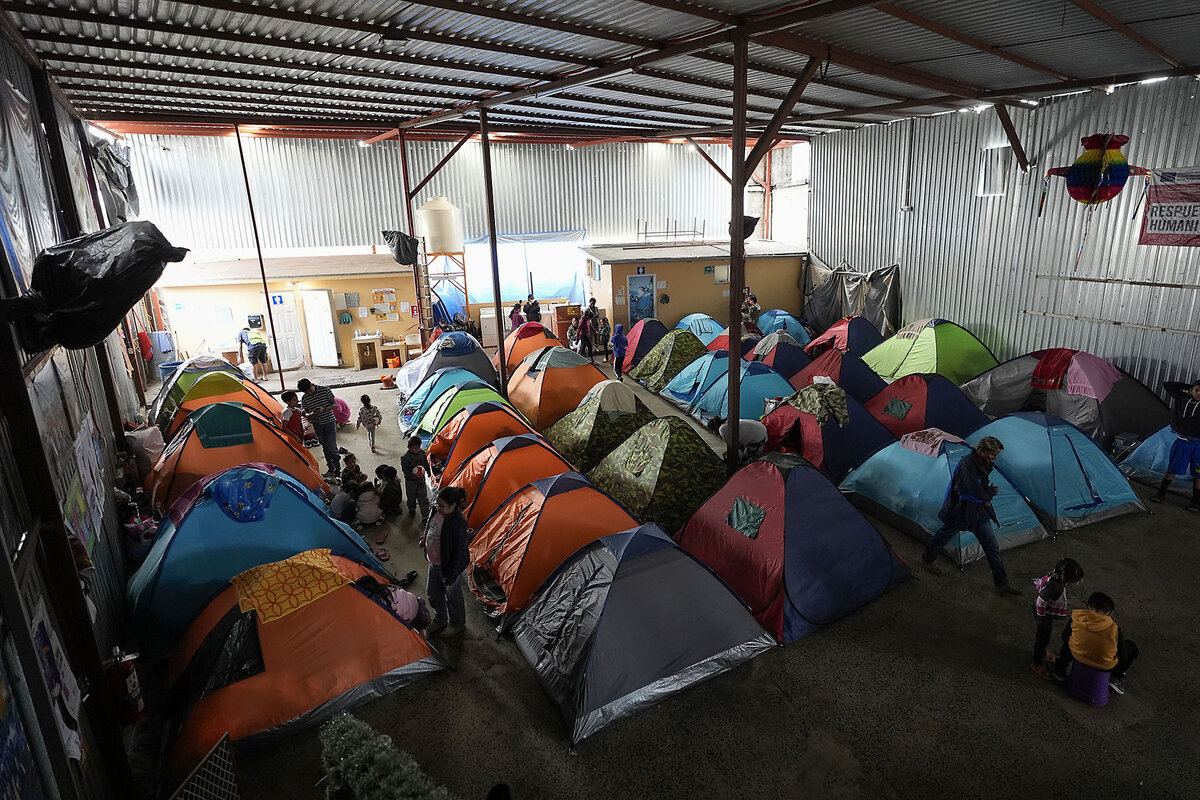
- Quick Read
- Deep Read ( 5 Min. )
When Pat Murphy became director of the Casa del Migrante in Tijuana in 2013, the shelter exclusively served men deported from the United States.
Over the past several years, however, whom his shelter serves – and how – has transformed so frequently and dramatically that the Catholic priest says the only thing he can count on now is constant change.
Serving vulnerable populations at Mexico’s northern border has long been an exercise in flexibility. Local, national, and international policy changes – not to mention global events such as wars or pandemics – affect who is arriving, and in what numbers. There is limited government assistance and oversight for migrant services, with civil society and religious organizations often stepping in to fill gaps in support.
But in recent years, changes at the border have been particularly rapid and dramatic – from evolving legal procedures for entry into the U.S. to the fluctuating demographics of those arriving. This is forcing organizations working with migrants in Mexico to become more nimble. Meanwhile, as both Mexico and the U.S. prepare for presidential elections this year, immigration and border control are taking center stage in political discourse – and in policymaking.
Migrants, Mexican aid groups adapt to shifts at US border
When Pat Murphy became director of the Casa del Migrante here in 2013, the shelter exclusively served men deported from the United States.
Running a migrant shelter at the U.S.-Mexico border was challenging, he recalls, but after a few years, he settled into a routine. “I remember thinking, ‘OK, I’ve got it now. I know what to expect,’” says Padre Pat, as the Catholic priest is known.
Sitting behind his desk in a small meeting room at the shelter, which overlooks this sprawling city, he laughs at his naiveté. Over the past several years, whom his shelter serves – and how – has transformed so frequently and dramatically that he says the only thing he “expects” now is constant change.
From evolving legal procedures at the border to the fluctuating demographics of those arriving, these shifts are forcing organizations working with migrants in Mexico to become more nimble than ever before. And as both Mexico and the U.S. prepare for presidential elections this year, immigration and border control are taking center stage in political discourse – and in policymaking.
“It’s complex because the response is always reactive,” says María Inés Barrios de la O, a professor of migration studies at the College of the Northern Border near Tijuana. “Whenever there’s a change, especially in migratory policy, it affects the flow and permanence of migratory populations. That’s a challenge squarely for civil society, because they’re the ones attending to these individuals,” she says. “Changes happen day to night, and the challenges just accelerate.”
An open-air waiting room
Serving vulnerable populations at Mexico’s northern border has long been an exercise in flexibility. Local, national, and international policy changes – not to mention global events such as wars or pandemics – affect who is arriving, and in what numbers. There is limited government assistance and oversight for migrant services, with civil society and religious organizations often stepping in to fill gaps.
But as Padre Pat’s experience suggests, the past eight years have been a particularly complex time at the U.S.-Mexico border. He refers to the unexpected swings in “stages.”
- The arrival of new groups of foreign nationals, predominately Haitians.
- Large-scale caravans of migrants arriving from Central America.
- The 2019 Migrant Protection Protocols, known as the “Remain in Mexico” program, which returned tens of thousands of migrants back to Mexico to await court dates in the U.S.
- The COVID-19 pandemic and U.S. policies like Title 42 that essentially shuttered the border.
- The expansion of a U.S. mobile app for asylum-seekers, which has meant migrants are congregating in nonborder cities, straining support networks in new ways.
He knows there’s more on the horizon. U.S. border states such as Texas are now experimenting in their own, often severe, border enforcement. Large groups traveling north toward the U.S. started migrating together once again in the new year. Last December saw a monthly record number of U.S. Border Patrol encounters at the border.
Mexico’s border cities have coped in diverse ways.

Over the past 40 years, Tijuana, on the traditional migratory route, has developed an infrastructure of services supported largely by churches and nongovernmental organizations, from soup kitchens to shelters like Casa Del Migrante to health clinics.
On the other hand, until 2019, all of Ciudad Juárez, which sits across from El Paso, Texas, had only two shelters. With a reputation for high murder rates and disappearances in the early 2000s, the city wasn’t somewhere migrants or deportees eyed – or lingered. But then came policies like “Remain in Mexico.” Within five years, the number of shelters in Ciudad Juárez grew to nearly 40.
Oversight for these migrant support services is thin, and government funding – though never sizable nor consistent – has essentially disappeared under the austerity measures of Mexican President Andrés Manuel López Obrador.
For shelter directors and service providers, that means relying more on fundraising. Much of their support comes from American organizations, and increasingly over the past five years from international groups like Save the Children or the United Nations.
Meeting migrants where they are
Ximena Rojas García remembers watching with anxiety as crowds of Haitians and migrants from various African countries gathered at a Tijuana border crossing in 2016. So many of the women standing for hours exposed to the elements were pregnant or traveling with small children. Ms. Rojas wondered, who was caring for them? A trained midwife, she started showing up with jugs of water and food, and offering prenatal exams in the back of her car.
Today, Ms. Rojas has a birthing center by the beach and several clinics near the border crossing in Tijuana, part of a crossborder health NGO she co-founded in 2018 called the Refugee Health Alliance (RHA).
On a recent afternoon in an RHA clinic, a midwife crouched by a patient in the waiting room with a Haitian Creole translator at her side. She explained the woman’s lab results and handed her a prescription for a diabetes test and an antibiotic, along with two small bags of dried herbs to steep in water and drink before bed.
The clinic was relatively quiet, but that can quickly change. Ms. Rojas recalls a day in 2022 when staff couldn’t open the doors in the morning because hundreds had already lined up outside clamoring for appointments. She later learned of a rumor: that people could cross the border legally with a letter from a medical professional pledging good health.
“All of the changes at the border make families stress, and struggle for answers,” she says. “Often, we’re all guessing.”
Although Mexico guarantees the right to health care for all migrants, regardless of legal status, the public health system is oversaturated. Whether intentionally or out of a lack of knowledge, administrators often require Mexican social security numbers or other paperwork that excludes those uprooted.
“There’s not a single day without surprises,” says Idsel Mosqueda, a psychologist at RHA. “We work with the resources we have, and they’re limited. But we also have hope.
“There’s power in having a space where people can feel safe, heard, and seen,” she says. “Even in chaos we can ask, ‘What do you need in this moment?’”

The Explainer
Filing taxes is hard. A new IRS program could change that.
It takes Americans more than a billion hours, collectively, to prepare their tax returns. A new IRS program could help certain filers.

- Quick Read
- Deep Read ( 3 Min. )
As the mid-April tax deadline fast approaches, many U.S. taxpayers will turn to professionals or pay to use software. The fear of making a mistake or missing out on one of the deductions in the sprawling tax code is very real.
But does filing in the United States have to be so hard?
In dozens of countries, most taxpayers don’t need to file a return. Governments withhold taxes during the year and send out information for taxpayers to review and approve.
This tax season, help could be on the way for certain filers. The Internal Revenue Service is rolling out Direct File, a free alternative to software such as Intuit’s TurboTax. Although the pilot program has its critics, advocates see it as a step toward simplifying tax season.
Filing taxes is hard. A new IRS program could change that.

Individual taxpayers in the United States collectively spend 1.7 billion hours each year getting their returns ready. As the mid-April tax deadline approaches, it seems fair to ask: Does filing have to be this hard?
Given the difficulty of deciphering complicated rules and the fear of making a mistake or missing out on a deduction, many people turn to professionals or pay to use software. But this tax season, help could be on the way for certain taxpayers. The Internal Revenue Service is rolling out Direct File, a free alternative to software such as Intuit’s TurboTax. Although the pilot program has its critics, advocates see it as a step toward simplifying tax season.
Why is filing taxes so complicated?
A 2022 paper found that the IRS could complete nearly half of Americans’ individual tax returns using data it already has on wages, unemployment benefits, interest, dividends, capital gains, and more.
But the IRS doesn’t know everything, especially when it comes to eligibility for certain tax breaks and credits. The study found that pre-populated returns would be most accurate for filers who are single, have no dependents, don’t qualify for credits or deductions, and have less than $100,000 in wages.
Critics say the tax preparation service industry also has a stake in keeping the process too hard for many taxpayers to navigate alone. The industry, with revenue estimated at $13.9 billion in 2023, employs nearly 270,000 people. Since 2006, Intuit has reportedly spent $25.6 million on government lobbying, and H&R Block, another provider of tax software, has spent $9.6 million.
How does Direct File work, and what are its pros and cons?
The goal is to give taxpayers a free, easy option for filing directly to the IRS, without going through a third party. The idea has been around for years but got a boost from $15 million earmarked in the Inflation Reduction Act to explore its feasibility.
For now, Direct File is available to residents in 12 states: Arizona, California, Florida, Massachusetts, Nevada, New Hampshire, New York, South Dakota, Tennessee, Texas, Washington, and Wyoming. It works similarly to the software offered by Intuit and H&R Block, with questions that guide users through the process, plus real-time chat support from IRS representatives. But Direct File isn’t currently available to gig workers and those who itemize deductions, earn income from retirement accounts, or make more than $200,000 individually or $250,000 as a couple. And state tax returns must be completed separately.
In late January, 13 Republican attorneys general wrote to Treasury Secretary Janet Yellen opposing Direct File. “American taxpayers do not want to invite the proverbial fox into the hen house,” they wrote. “There’s an obvious conflict of interest when the IRS acts as tax preparer, filer, and auditor.”
How have other countries simplified the tax-filing process?
In dozens of countries, most taxpayers don’t need to file a return. Governments withhold taxes during the year and send out information for taxpayers to review.

“Rising Income Tax Complexity,” Youssef Benzarti and Luisa Wallossek
“You just have to look it over, make corrections, or accept it, and you’re done,” says Joel Slemrod, an economist at the University of Michigan. As of 2021, some 33 of the 38 countries in the Organization for Economic Cooperation and Development fully or partially pre-populate tax returns.
In Spain, 70% of taxpayers receive a pre-filled return, and half make no changes. In the United Kingdom, most taxpayers don’t need to file a tax return at all under an exact-withholding system.

“Rising Income Tax Complexity,” Youssef Benzarti and Luisa Wallossek

Moscow plans mini-Olympics. Will Russians be satisfied?
As the West has isolated Russia, Moscow has worked fervently to create alternatives to global commodities. But when it comes to Olympic-level athletic competitions, the Kremlin’s proxies may not pass muster with the Russian public.
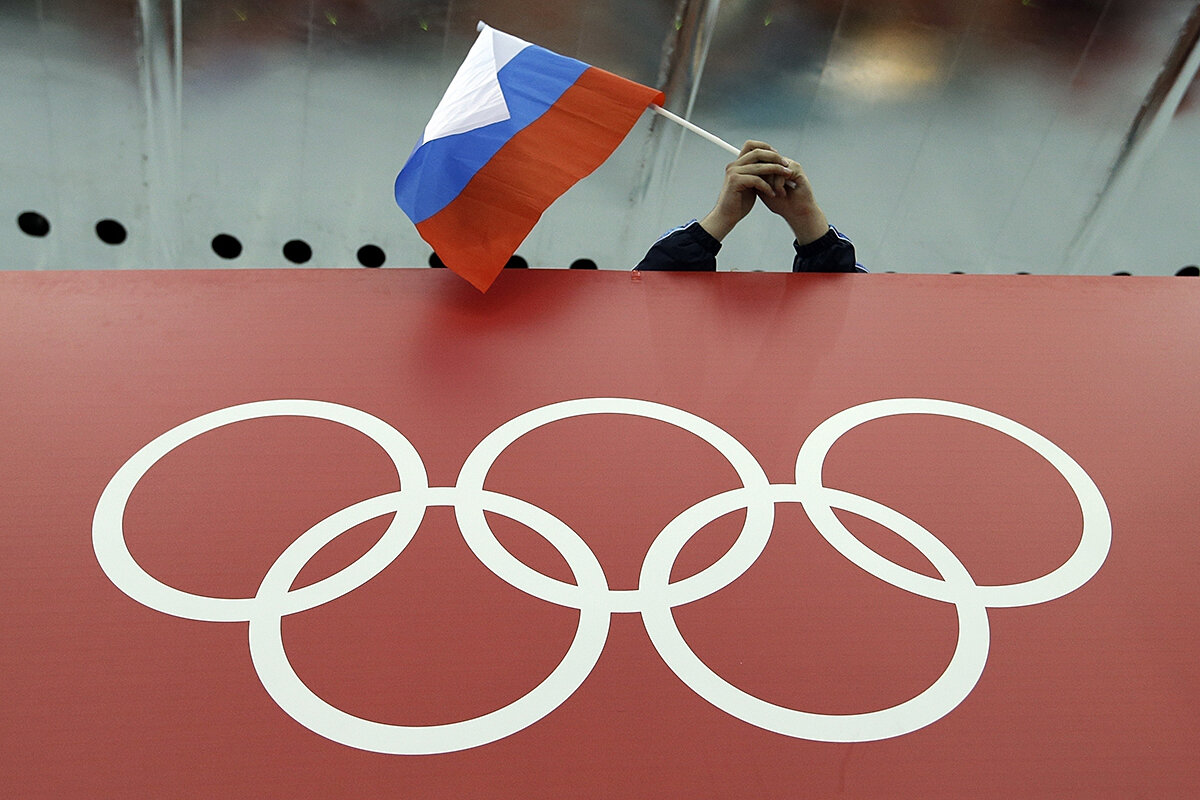
- Quick Read
- Deep Read ( 5 Min. )
In September, just a month after the 2024 Paris Olympics, Russia will launch the World Friendship Games, a Soviet-inspired extravaganza.
It looks like a full-scale substitute event for the Games, meant to defy the International Olympic Committee’s ban on Russian athletes competing under their own flag. Russian officials insist that it isn’t, but rather that Russian, Belarusian, and other voluntary international participants will compete for large cash prizes and other honors.
Nonetheless, Moscow’s decision to launch these games has generated controversy in Russia, drawn condemnation from the International Olympic Committee, and offered a select number of Russian athletes a dubious choice between taking part in these patriotic events or trying to compete in Paris as “neutral” or independent contestants.
The Kremlin has authorized a huge budget equivalent to $90 million for this year’s World Friendship Games, including around $50 million in prize money. Though Olympic-level competitors from outside the sanctioned countries of Russia and Belarus seem unlikely to attend, second-tier athletes from other countries are welcome. Organizers optimistically claim the Friendship Games may draw up to 10,000 athletes from 137 countries.
“These alternative games cannot possibly substitute for the Olympics,” says Alexander Shprygin, a controversial sports commentator. “But at least athletes will be able to compete and achieve some of their goals.”
Moscow plans mini-Olympics. Will Russians be satisfied?
Russian athletes may still be banned from competing with their national flag or anthem in this year’s Olympics. But Moscow has a plan to keep its sports institutions intact, its athletes busy and well paid, and, it hopes, Russian fans satisfied.
In September, just a month after the 2024 Paris Olympics, Russia will launch the World Friendship Games, a Soviet-inspired extravaganza that looks like a full-scale substitute games meant to defy the International Olympic Committee’s ban. Russian officials insist that it isn’t intended to replace the Olympics, but rather that Russian, Belarusian, and other voluntary international participants will compete in many Olympic categories for large cash prizes and other honors.
Nonetheless, Moscow’s decision to launch these games and several other brand-new international sporting events has generated controversy in Russia, drawn condemnation from the IOC, and offered a select number of Russian athletes a dubious choice between taking part in these patriotic events or trying to compete in Paris as “neutral” or independent contestants.
“Only a very limited number of [Russian] athletes will qualify” to compete in Paris, the IOC said in a statement in mid-December. “Among the 4,600 athletes from around the world who have qualified for Paris 2024 so far, there are only 11 Individual Neutral Athletes,” six with a Russian passport, plus five with a Belarusian passport.
And while few Russians are happy about the Olympic ban their athletes face, it is unclear whether they will find these new competitions a satisfactory replacement.
Political games
The former Soviet Union was completely isolated from global sports until 1952, when it joined the Olympic movement. Soviet athletes quickly became a regular, highly successful fixture on the international sports scene.
Then in 1984, at a particularly bad juncture of the Cold War, the USSR and its allies decided to boycott the Los Angeles Olympics to prevent their athletes from being targeted for political condemnation over the Soviet invasion of Afghanistan. Instead, it staged a rival event, the Moscow Friendship Games, in which 50 countries participated. Few Russian sports experts today express any warm memories of those games or believe they contributed anything useful to world sports.
“You can call it anything you like, World Games or Universal Games, and offer astronomical awards, but such artificially invented competitions will never become real alternatives or drive athletes to better achievements,” says Eduard Sorokin, an independent Russian sports journalist. “At the end of the day, they will be lackluster political spectacles that have no lasting impact.”
Supporters of the alternative games include, ironically, many top Russian champions who made their names in international games and now occupy honored places in Russian society. Former NHL hockey legend Viacheslav Fetisov, now a deputy in the lower chamber of parliament with the pro-Kremlin United Russia party, accused the IOC of “trampling on the rights” of all sports fans by banning Russian athletes from competing under their own national symbols. “The IOC burned the bridges, and it’s not known what they intend to replace them with,” he told journalists.

Irina Rodnina, a three-time Olympic figure skating champion who is also a Duma deputy, said that previous Olympic bans targeted Russian athletes for alleged doping, often with good reason. Now, she told the Russian media, “there are no complaints about the athletes, but there are complaints about the country. In this situation, I do not know, maybe I am from another generation, I would not go! With a flag or without a flag, I wouldn’t go at all! Because this is humiliation of the country.”
In order to participate in the Olympics as independent competitors, Russian athletes will need to demonstrate that they have no links to military or security services and do not support the war in Ukraine, as well as be willing to forgo their Russian national affiliation. That may leave many condemned to languish without any access to world-class competitions until the global geopolitical crisis is resolved.
Experience in previous Olympics in which Russian national symbols were banned suggests that the Russian public and players alike deeply resent the limitations put upon their participants, though it is not clear whether they will embrace the alternative games being ginned up by Russian authorities.
How much do Russians care?
In addition to the World Friendship Games in Moscow and St. Petersburg, which will largely track the sporting categories of the Summer Olympics, there will be a winter version called the Winter Spartakiad, probably to be held in Sochi, site of the last Olympic Games to be hosted by Russia in 2014. Also on the drawing boards is a projected BRICS Games competition, which is aimed at drawing athletes from the Global South. Russian sports authorities have talked about making a “turn to Asia” in their competitive focus that conforms with Russia’s broader political and economic realignments.
Some Russian athletes may find a way to compete as neutrals in the Olympics and other international venues. For the rest, the alternative games offer a make-work project for athletes to continue in some kind of competition, and also to earn money to keep going.
The Kremlin has authorized a huge budget equivalent to $90 million for this year’s World Friendship Games, including around $50 million in prize money. Though Olympic-level competitors from outside the sanctioned countries of Russia and Belarus seem unlikely to attend, second-tier athletes from other countries are welcome. Organizers optimistically claim the Friendship Games may draw up to 10,000 athletes from 137 countries.
Denis Volkov, director of the Levada Center, Russia’s only independent public opinion agency, says there’s been no good polling on Russians’ feelings about being excluded from big swaths of international sports. But the subject does come up in the focus groups his agency runs, and, he reports, about half of respondents say they acutely feel the isolation. “Everyone seems sorry about it and thinks it’s a bad thing,” he says. “The bigger part [of respondents] say Russia bears no blame, and the West is just plotting against us using Ukraine as a pretext. A smaller part blames Putin.”
As for the wider sense of being shut out, at least from the Western world, Mr. Volkov says there is little evidence that Russians care very much. “Sports is one field where the isolation is felt, but in general people don’t seem very worried. It should be pointed out that only about 20% of Russians have ever traveled abroad, and that’s a small part of the urban population. When the subject comes up, a lot of people object that we’re not really isolated because we have good relations with China. And polls do show that China’s image has improved with the Russian public.”
In the final analysis, the alternative games may keep Russian athletics on life support, at least for now.
“These alternative games cannot possibly substitute for the Olympics, but at least athletes will be able to compete and achieve some of their goals,” says Alexander Shprygin, a controversial sports commentator and former sports adviser to the right-wing, populist Liberal Democratic Party. “So the main purpose is to support the athletes, not to please the fans. All of them, athletes and fans alike, are just hostages of the political situation.”
Editor’s note: The story has been updated to clarify the number of Russian athletes who have the choice to attend international competitions like the Olympics.

Points of Progress
In science and conservation, empowering the people
In our progress roundup, we look at new ways of compensating people who have less agency. People who participate in research studies are increasingly being informed of the results. And rural residents are both conserving and harvesting their forest environments.
In science and conservation, empowering the people
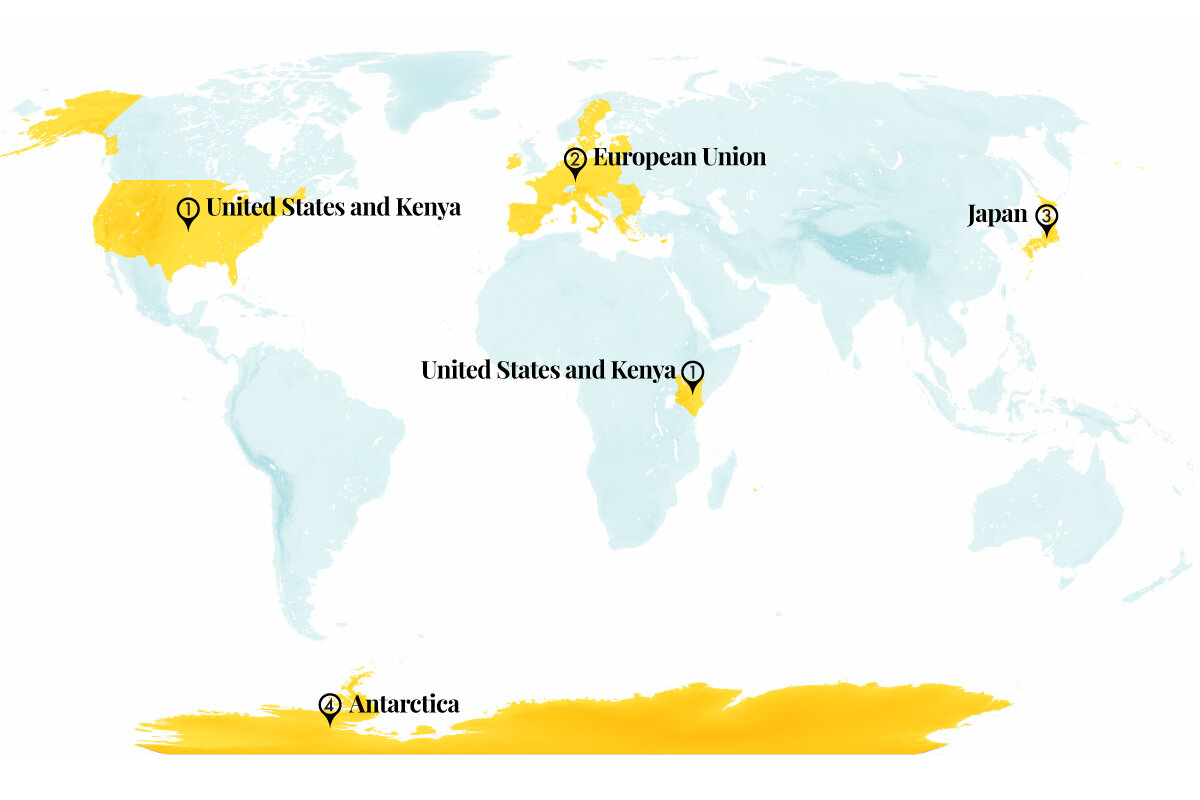
1. United States and Kenya
More scientists are sharing their study results with participants as they seek to raise ethical standards. In an international survey of clinical trials from 2014 to 2015, only about one-quarter of researchers said they provided participants with a summary of their findings in language understandable to a layperson.
But in an example of how scientists can create better connections even with remote communities, Carla Handley of Arizona State University readily agreed in 2017 to share the results of her genetics research on the Borana ethnic group in northern Kenya, at community elders’ request. A new project funded by the National Institutes of Health later made it possible for Dr. Handley and her colleagues to return to Kenya and track down participants. They used beads to explain the study to members of a community that had not had the opportunity to learn to read.
Dr. Handley said their responses emphasized that people can be interested in topics that are normally only introduced in formal education. “Even I – working there for a long time – didn’t give people enough credit for the amount of curiosity there was,” said Dr. Handley.
In 2018, the National Academies of Sciences, Engineering, and Medicine recommended that more researchers share results with study subjects. And last year, the United Kingdom announced plans to require researchers to share results with participants or explain why that isn’t possible.
Sources: NPR; National Academies of Sciences, Engineering, and Medicine
2. European Union

Pharmaceutical and cosmetic companies will be required to clean up micropollutants and microplastics in wastewater under new rules, following the “polluter pays” principle of environmental law. Through the process of bioaccumulation in living organisms, PFAS chemicals and other micropollutants can build up over time, multiplying their harmful effects. Under the directive, manufacturers will be responsible for paying for 80% of the associated costs of micropollutant removal. European Union governments will pay the rest to prevent products from becoming too expensive.
The new rules have been agreed upon by the European Parliament and the Council of the EU but not formally adopted. By 2035, EU members must remove organic matter from wastewater in all communities with more than 1,000 people. Additionally, by 2045, they must remove nitrogen and phosphorus – which can cause toxic algae blooms – from treatment plants covering more than 10,000 people if there is a risk to the environment. And governments will have to monitor sewage for microplastics, PFAS (often described as”forever chemicals”), and antimicrobial resistance.
The directive is part of a broad push by the EU to combat water pollution, though critics say some governments have been slow to enforce existing wastewater rules. Last year, the EU banned intentionally added microplastics, such as microbeads in shower gels.
Sources: The Guardian, Reasons to be Cheerful
3. Japan
More married women are entering the labor force, underscoring a shift in attitudes around women and work. National policy and cultural convention have long encouraged women to quit their jobs after having a child. But in 2022, there were a record 30.35 million working women in Japan, and the share of households with a stay-at-home wife dipped below 30%.
Last October, a report found that some 1.1 million married women were limiting their work hours to avoid reaching the level (about $8,900 annually) at which employees pay into public pension and insurance programs. The government announced that it would provide subsidies to mitigate the effects of the “income wall.” At home, most duties still tend to fall to women: Just 17% of Japanese men use parental leave when it’s available, and women spend five times more hours on chores than men do.

Advocates say a greater cultural shift is needed to ease the stark choice between career and family for women. While economists agree that societies making full use of women’s skills are more productive and prosperous, Japan’s government has struggled for two decades to fulfill promises to create policies that engage women in work and government more fully. The pension program is due for its regular review next year, when experts anticipate lawmakers will enact further reforms.
Sources: The Economist, Forbes, The Japan Times, The New York Times
4. Antarctica
A scientist discovered four colonies of emperor penguins via satellite images. Unlike other penguins, the iconic birds rely on “landfast” ice attached to the shore for breeding in the winter. In 2022, landfast ice coverage fell to the lowest level ever recorded, leading to the likely loss of chicks that lack waterproof feathers before fledging. The discovery of about 5,700 pairs of the world’s largest penguins across four sites marks a rare bright spot for the species, which scientists estimate could face population collapse by the end of the century.
In images taken by two satellites between 2018 and 2022, one colony was previously thought to have disappeared altogether. The total number of known colonies is now 66. Scientists say they regularly comb through satellite photos searching for signs of the birds. Their characteristic brown guano can be seen against the backdrop of Antarctic ice even from space.

Geographic information scientist Peter Fretwell wrote that the discovery’s contribution to the total population is likely minimal, but that the findings provide vital insight into colony location and distribution. “As the resolution of satellites becomes greater,” wrote Dr. Fretwell, “it may be that some very small, unreported breeding aggregations may still be found that have been missed by coarser imagery.” There are some 600,000 emperor penguins remaining in the wild.
Sources: Smithsonian Magazine, Antarctic Science, The New York Times
World
Paying rural residents for reforestation – while also allowing them to harvest timber – can strike a balance among social, economic, and environmental concerns. Regrowing tropical forests is considered vital to the health of the Earth, and the Indigenous peoples who live on these lands are key to stewardship that also helps meet the world’s carbon mitigation targets. An analysis published in December looked at combinations of incentives for landholders to see how all three priorities could be maximized.
Early programs of payment for ecosystem services to landholders and carbon payments by corporations have been criticized for a focus on economic efficiency. Seeking to examine these efforts, the analysis made use of 1.4 million tree measurements taken over 15 years in Panama. Researchers examined a variety of sites and tree species, from naturally regrowing forests to an attempt to rehabilitate a teak plantation. The study noted at least one successful combination: when landholders were given reliable annual payments, not contingent upon the size of their trees, and allowed to harvest timber from their labor. The incentives created more vibrant forests in the long term, and the income was competitive compared with less sustainable options for the landholders, such as cattle rearing.
Sources: The Conversation, Nature Communications

Other headline stories we’re watching
(Get live updates throughout the day.)The Monitor's View
A Mexican election offers freedom
- Quick Read
- Deep Read ( 2 Min. )
-
By the Monitor's Editorial Board
Few countries have achieved greater political gains for women in recent decades than Mexico. Now the country is poised to elect its first female president. The two leading candidates for the June ballot come from contrasting circumstances. Claudia Sheinbaum was raised in affluence by immigrant parents. Xóchitl Gálvez, who is ethnically Indigenous, grew up poor. Their personal differences, however, resonate less than their professional qualifications.
Both women are trained scientists with successful political careers. They eschew personal attacks and emphasize equality and compassion. Between them, they have garnered support from 90% of voters. In a country where 70% of women have experienced some form of violence, many Mexicans glimpse a future beyond fear and limitation.
Mexico’s contest between two leading female presidential candidates reflects a continuing shift in attitudes – fueled partly by quotas – about gender equality in Latin America. These attitudes show widening recognition and respect for the qualities and qualifications that women bring to leadership.
A Mexican election offers freedom
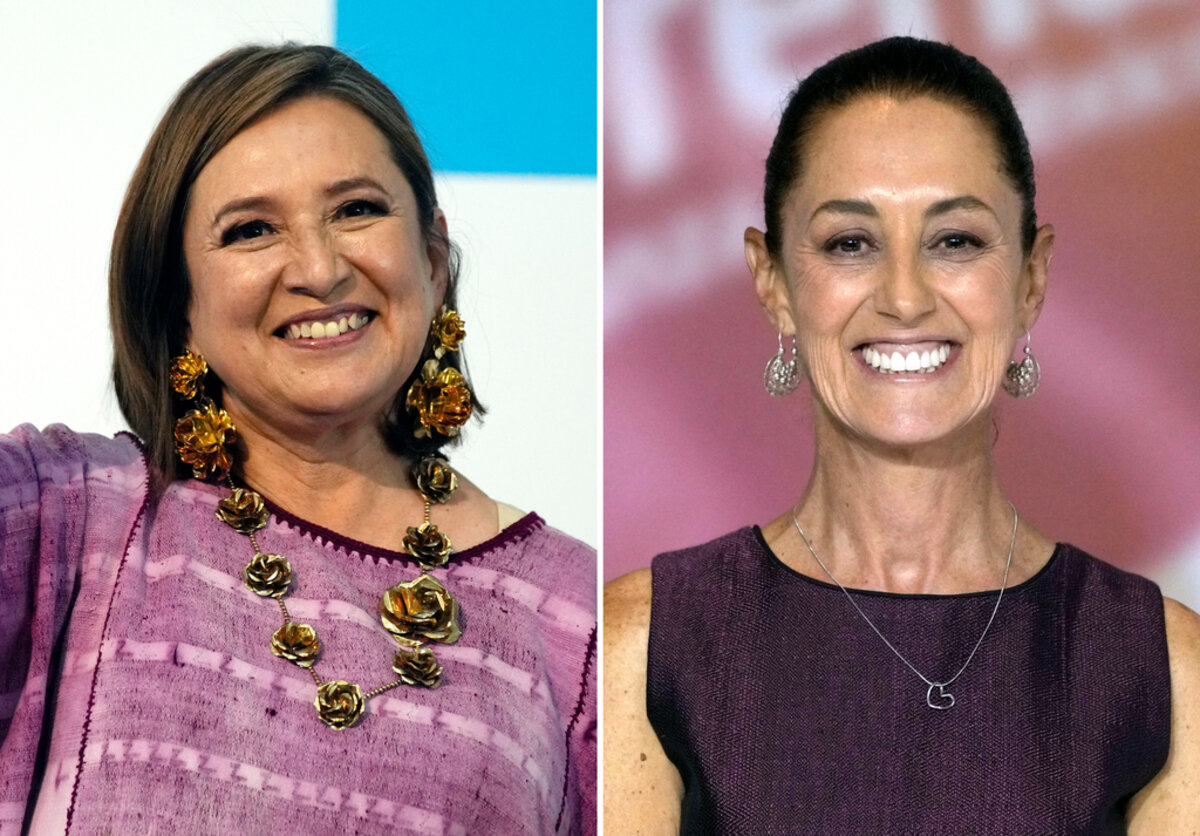
Few countries have achieved greater political gains for women in recent decades than Mexico. Half of the Cabinet and national legislature is female. So are the country’s chief justice and a third of all state governors. In a landmark ruling last fall, the Supreme Court decriminalized abortion.
Now the country is poised to elect its first female president. The two leading candidates for the June ballot come from contrasting circumstances. Claudia Sheinbaum was raised in affluence by immigrant parents. Xóchitl Gálvez, who is ethnically Indigenous, grew up poor. Their personal differences, however, resonate less than their professional qualifications.
Both women are trained scientists with successful political careers. They eschew personal attacks and emphasize equality and compassion. Between them, they have garnered support from 90% of voters. In a country where 70% of women have experienced some form of violence, many Mexicans glimpse a future beyond fear and limitation.
This is “a historic moment: cheering on our future president, who is, moreover, a scientist,” Brenda Suarez, a shopkeeper, told Le Monde during Ms. Sheinbaum’s election kickoff in Mexico City last Friday. “My two daughters already see Claudia as a role model.”
Mexico’s contest between two leading female presidential candidates reflects a continuing shift in attitudes – fueled partly by quotas – about gender equality in Latin America. Twelves countries in the region have been led by women. While gender gaps persist, a 2021 Gallup poll found that strong majorities – ranging from 75% to 92% – in every country of the region expected to see a female head of state within a decade. Across the region, a median average of 46% expressed a preference for female managers in their jobs.
These attitudes reflect widening recognition and respect for the qualities and qualifications that women bring to leadership. As Jennifer Piscopo, a professor of gender and politics at the University of London, has observed, in Latin America, voters tend to associate women with political renewal and trust. “As the group traditionally excluded from political power, women often signal a fresh start and then repudiation of corrupt elites, making them more attractive candidates.”
On the campaign trail, Ms. Sheinbaum, the ruling party candidate, and Ms. Gálvez outline economic and security proposals that differ by degrees. But their stump messages align on seeking justice for all Mexicans, protection for women, and honest governance over corruption.
“In a country where women – especially minority women – struggle to survive, Gálvez and Sheinbaum studied science, shaped policy, and crafted resumes worthy of presidential bids,” Professor Piscopo wrote last week in Ms. Magazine. “The symbolism is huge,” she told the Financial Times.

A Christian Science Perspective
Each weekday, the Monitor includes one clearly labeled religious article offering spiritual insight on contemporary issues, including the news. The publication – in its various forms – is produced for anyone who cares about the progress of the human endeavor around the world and seeks news reported with compassion, intelligence, and an essentially constructive lens. For many, that caring has religious roots. For many, it does not. The Monitor has always embraced both audiences. The Monitor is owned by a church – The First Church of Christ, Scientist, in Boston – whose founder was concerned with both the state of the world and the quality of available news.
Know what you are
- Quick Read
- Read or Listen ( 3 Min. )
-
By Lois Degler
We experience great freedom from seeing more clearly the incorruptibility of our God-given, spiritual selfhood.
Know what you are
For many years certain circumstances would trigger in me a response of self-condemnation, followed by feelings of great unworthiness. It was a miserable cycle. And then one day, within that predictable scenario a gentle correcting message came to me: “This is not you.”
Recognizing this as a Christly message from God, divine Love, I found this to be an instant wake-up call to stop entertaining unloving thoughts about myself and instead remember what I am as God’s creation. I felt washed clean. Since then I’ve not been tricked into that destructive thought pattern. Such freedom and peace!
There’s an account in the Bible that deeply resonates with me about how important it is to know our true identity as God’s children. After a shipwreck during his voyage to Rome as a prisoner, the Apostle Paul and others find safety on an island (see Acts 28:1-6). The island natives treat them kindly, making a warm fire to welcome them. But as Paul is adding a bundle of sticks to the fire, a poisonous snake is driven out by the heat and fastens itself on his hand. Seeing this, the natives assume he is a murderer who is now being rightfully punished. Paul’s response is to immediately shake off the viper into the fire, without any hurt to himself.
We might see Paul’s act of shaking the serpent off into the fire as symbolizing his rejection of the poisonous accusation that he is a sinful mortal with an ugly past. Earlier in Paul’s life, although it’s not clear whether he himself was a murderer, he’d given consent to the persecution and murder of Christians and stood by watching while murder was committed. But Paul experienced a change of thought and character after he came to a new understanding of Christ Jesus as the promised Messiah (see Acts 9:1-20). He summed up this change, assuring others that “if any man be in Christ, he is a new creature: old things are passed away; behold, all things are become new” (II Corinthians 5:17). He understood that his life was “hid with Christ in God” (Colossians 3:3).
Paul’s experience illustrates that the Christ presence makes God known to us in a new way. Mary Baker Eddy describes “Christ” in “Science and Health with Key to the Scriptures” as “the divine manifestation of God, which comes to the flesh to destroy incarnate error” (p. 583). The Christ is always speaking to human consciousness, showing us what we each are, made in the image and likeness of God. That spiritual perception enables us to drop any destructive view of ourselves and others as material personalities with a material history. We’re made new.
For some time prior to that life-changing message I received – “This is not you” – I’d been praying each day with a heartfelt desire to be made new, to be washed clean of everything that wasn’t representing my reflection of God’s goodness. The human personality includes dualistic characteristics: good and productive ideas and opposite concepts and traits. From this point of view, the world is seen as material, having its own power to create and to govern, and a matter-created man as having a good and bad mind of his own. Such a conclusion suggests something other than God, Spirit, who is infinitely good, as the creator of man and the universe.
Christian Science declares that it is impossible for there to be a creator other than God, or for man (any individual) to be anything other than God’s spiritual creation. The first chapter of the Bible affirms that God is good and made man in His image, after His likeness. This man isn’t a world-shaped material personality but a Godlike spiritual individuality.
To accept the truth requires us to sacrifice a sense of ourselves as finite, material identities. But with this sacrifice, we gain a clear, accurate, spiritual view of what we actually are, which brings a genuine sense of self-worth and true joy to our human experience.
God, because of His great love for us, intends for us to know Him, and enables each of us to know ourselves and others as we have been created by Him. And so He is constantly leading us through Christ to a fuller view of the divine reality of what we truly are.
Adapted from an article published in the Jan. 13, 2020, issue of the Christian Science Sentinel.

Viewfinder
Super Tuesday, Vermont-style
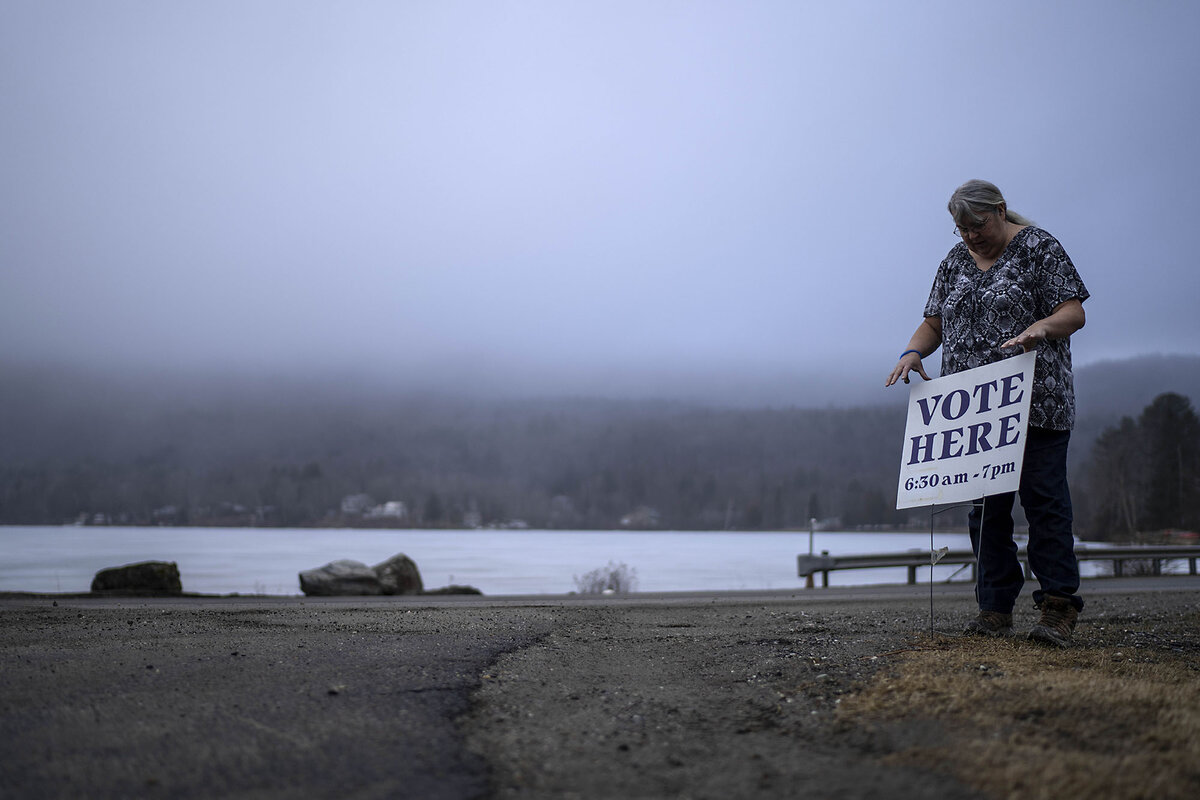
A look ahead
Thank you for joining us today. Tomorrow, we’ll have our wrapup of the Super Tuesday primary elections in the United States, as well as our film reviewer’s picks, ahead of the Oscars, for the top acting performances of 2023.



